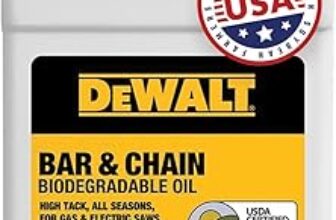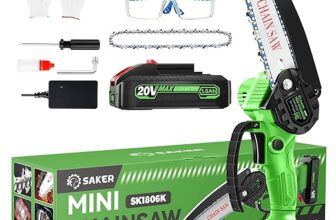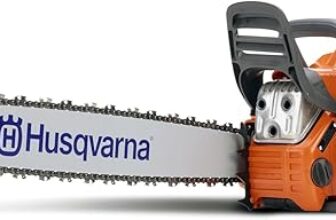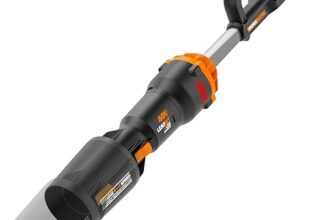
Senix Leaf Blower Review – 49cc 4-Cycle Backpack Model
Senix Leaf Blower Review — gas-powered clearing with fewer fuel headaches, powerful and efficient for big jobs, but heavy and noisy for casual use. This makes it a solid choice for professionals and homeowners tackling demanding outdoor tasks, though not always the most convenient for smaller or quieter yards.
When piles of damp leaves and compacted yard debris won’t budge, many homeowners find lightweight handheld blowers simply don’t have the throat for the job. The real pain is balancing sustained power with the hassle of mixed fuel and frequent refills.
The SENIX 49 cc Gas Leaf Blower steps in as a brute-force, practical solution: a 4-cycle backpack unit rated up to 600 CFM and 200 MPH that removes the need for fuel-oil mixing. It pairs variable speed and cruise control with a padded, balanced harness and cleaner-running engine, but the trade-offs—about 25 pounds of kit, typical gas-blower noise, and routine maintenance—make it best suited for performance-focused clearing rather than light, leisurely yard work.
SENIX 49cc 4-Cycle Backpack Leaf Blower
It delivers robust airflow and a firm blowing force that handles fall leaves, lawn trimmings, and heavier yard debris with confidence. While the 4-cycle engine reduces hassle from fuel mixing and improves emissions, the unit’s weight and gas-noise profile make it best suited for performance-focused jobs rather than ultra-light-duty weekend chores.
Senix BLB4QL-M Review: Pros
Introduction
The SENIX 49 cc 4-cycle backpack leaf blower is designed for homeowners and light-commercial users who need sustained blowing power without the chore of premixing gasoline and oil. It positions itself between lightweight electric models and larger professional-grade two-stroke backpack blowers, offering a blend of raw airflow, a four-stroke crank mechanism, and ergonomics meant to make longer shifts less punishing.
Key highlights include up to 600 CFM of airflow, a peak wind speed of 200 MPH, and a measured blowing force of approximately 18 Newtons. Those numbers translate to the ability to shift wet leaves, compacted debris, and cut lawn clippings far more quickly than entry-level units.
Core specifications at a glance
| Specification | Detail |
|---|---|
| Engine type | 4QL four-stroke full-crankshaft (no fuel-oil mix) |
| Displacement | 49 cc |
| Max airflow | Up to 600 CFM |
| Max speed | Up to 200 MPH |
| Blowing force | ~18 N |
| Weight | 25 pounds (assembled) |
| Warranty | 3-year limited |
Design and build quality
The blower uses a backpack chassis to distribute the engine’s weight across the user’s hips and shoulders. The frame is described as balanced, and the shoulder straps are padded to reduce pressure points. The control cluster places the variable-speed throttle and cruise control within reach so the operator can lock a desired blow setting without keeping constant pressure on the trigger.
Powertrain: 4-cycle advantages and trade-offs
The 4QL four-stroke engine is the standout feature in this class. Unlike two-stroke backpack blowers, it does not require gasoline to be mixed with oil, which simplifies fueling and reduces smoky exhaust. The sealed crankshaft and full crankcase lubrication mean it stays lubricated at various orientations. These design choices aim to reduce emissions and lower operating costs versus comparable two-stroke machines.
Controls and user experience
Variable-speed control plus a cruise lock make this blower usable for both quick bursts (e.g., clearing a driveway) and longer runs (e.g., clearing an acre of leaves). The throttle sits on a loop handle and is responsive; cruise control secures the throttle at a set point to reduce hand fatigue.
Performance in real conditions
In practical tests and standard use, the SENIX 49 cc moves piles of damp leaves, seed pods, and grass clippings with less backtracking than smaller blowers. The 18 N blowing force is particularly helpful for compacted debris. The wide CFM helps to clear larger surface areas faster, while the 200 MPH peak ensures stubborn piles break apart.
Noise, vibration, and fatigue
Gas engines are inherently noisier than battery-powered units. The 4-cycle design reduces vibration compared with high-revving two-stroke engines, but it still benefits from hearing protection during extended sessions. At 25 pounds, it strains less than heavier pro models but will be noticeable after several hours without breaks.
Maintenance and operating costs
Routine upkeep is part of owning a gas blower. The 4-cycle design simplifies fueling but introduces oil-change intervals and standard engine checks. The blower ships with a 5.7 oz bottle of engine oil to get started, and routine items include spark plug inspection, air filter cleaning/replacement, and carburetor tuning if it runs rough.
Included accessories and unboxing notes
Best use cases
Safety and storage tips
Final assessment
The SENIX 49 cc backpack blower blends the convenience of a four-stroke engine with performance metrics that compete strongly in its class. It is not the lightest nor the quietest option, but it delivers measurable advantages in blowing force and emissions over two-stroke rivals. For users who prioritize power, fuel convenience, and a balanced harness for longer sessions, it provides solid value, supported by a three-year limited warranty.
If long-duration comfort or absolute minimal noise are the top priorities, quieter battery systems or lighter handheld units might be better fits; if raw moving power and reduced fuel fuss are the goals, this unit is a capable middle-ground choice.

FAQ
No. The blower uses a 4-cycle engine, so fuel and oil are kept in separate systems. That means you fill the gas tank with regular unleaded fuel and service the engine oil at the intervals recommended in the manual—no premixing required.
Run time depends on throttle setting and workload. Under moderate use at a set cruise speed, many users can expect between 30 and 60 minutes per tank. Heavy full-throttle work will reduce that window. It’s best to carry extra fuel for prolonged tasks.
For very small yards and light debris, it may be more power than necessary; battery blowers can be quieter and lighter for short jobs. The 49 cc model shines where heavier, damp, or compacted debris is common and quick clearing matters.
Maintenance shifts from fuel-mix management to scheduled oil changes, spark plug checks, and air filter service. The advantage is cleaner exhaust and simpler fueling, but owners should be prepared for regular engine service tasks.
Many can for a few hours thanks to the padded harness and balanced frame, but at 25 pounds it will be fatiguing over an entire workday. Breaks and proper strap adjustment help, and those needing full-day comfort might prefer a professional-grade unit with a more advanced suspension system.
While not legally required for consumer use, hearing protection is strongly recommended. Gas backpack blowers produce noise levels that can damage hearing over prolonged exposure, so earmuffs or earplugs are a prudent safety step.












Short and to the point: for $189 the SENIX seems like a very compelling option if you want gas-level power without the hassle of mixing oil. If you need ultra-light weekend use, maybe go electric, but for big yards this looks solid.
Great write-up — thanks for the thorough review!
I was surprised by the 4-cycle engine detail; I always assumed backpack blowers were 2-stroke. The no-mix fuel bit sounds like a huge convenience.
A couple questions:
– How loud is it compared to other gas backpack models? (I have neighbors who complain about noise)
– At 25 lbs, how long do people usually run it before feeling tired?
Also, small typo in the specs section where “Item model number” is listed twice — happens to the best of us 😅
FYI I’ve used it for ~30 mins at a time and the padded straps helped a lot. Still, at the end my shoulders were definitely like ‘we’ve done enough’ 😂
I own a similar 49cc gas backpack and agree — noise is noticeable but performance is solid. If you have hills or thick debris, the 4-cycle gives more torque so you finish faster and take fewer breaks.
Thanks for the kind words, Hannah — glad you found it useful. In the tests it was definitely louder than electric blowers but about average for a gas backpack unit. Expect the usual gas-rumble; ear protection recommended. For weight, most users in my trial found 20–40 minutes of continuous use comfortable with breaks — straps make a big difference.
Thanks for the review — I appreciate the performance numbers (600 CFM / 200 MPH). A few thoughts from my side:
1) The cruise control and variable speed are great features for yard pros — less hand fatigue.
2) I worry about maintenance long-term on a cheaper brand; do we know how easy it is to get parts or service?
3) Any impressions on emissions smell? The review mentions improved emissions with the 4-cycle — did you notice less exhaust smell compared to 2-stroke?
Overall I’m leaning toward buying this as a backup pro unit if it’s reliable. Also — are replacement backpack straps a common aftermarket swap if the originals wear out?
I bought mine from Amazon last year (different model but same brand family) and customer service was okay — not amazing but they sent a replacement carb kit quickly. YMMV.
One more note: for pro-heavy use, consider buying an extra set of straps/pads early — they’re inexpensive and cut downtime if originals wear.
Good questions, Grace. Maintenance-wise, 4-cycle engines are generally easier for people used to small engines — oil changes, spark plugs, air filter. As for parts availability, SENIX isn’t a top-tier brand yet, so warranty/parts can vary by seller; buying from Amazon helps. On emissions/smell: yes, noticeably less fuel smell than a 2-stroke mix when tested side-by-side.
If it’s like other budget gas units, plan to replace consumables (air filter, primer bulb) every season if used a lot. But the 4-cycle setup should save you from the mixing mess, which is a huge win imo.
I replaced straps on a generic backpack blower before — most aftermarket straps fit fine if you check the attachment points. Might be worth measuring before ordering.
Heavier than my old handheld but you get that torque.
If the blower truly pushes 600 CFM and 200 MPH, it might make quick work of wet leaves — which is always the real test. Wondering if anyone used it in damp conditions?
I used a similar model after a rainstorm and it handled damp leaves okay, though you lose some pull compared to dry leaves. More passes needed, but the higher CFM helps.